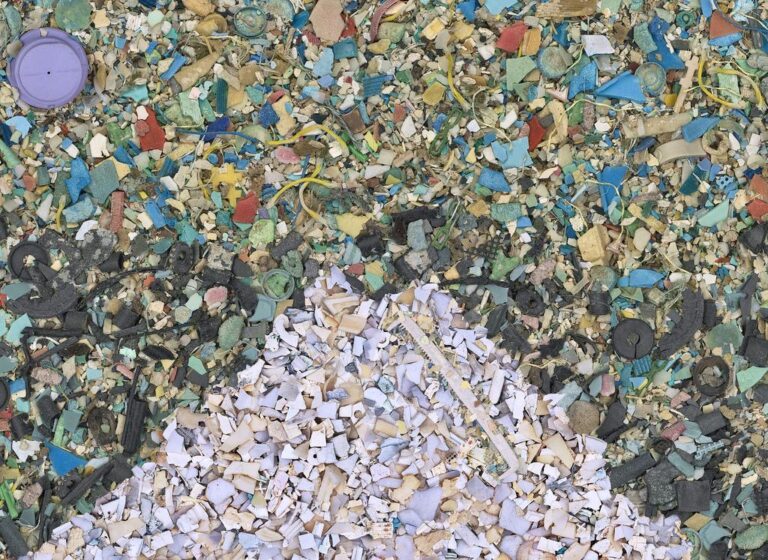From bottles and shopping bags to microbeads in cosmetics and the tiny shreds that rub off the soles of our shoes as we walk, vast amounts of plastics find their way into rivers, lakes and the sea.Scientists estimate that more than 5 trillion plastic particles are floating in oceans around the world – an amount that has accumulated since global mass production of plastics started in the 1950s.‘One of the potential impacts we are investigating is their impact on the exchange of carbon dioxide at the sea surface,’ said Dr Luisa Galgani, from the University of Siena in Italy.‘So far, we know that the ocean is absorbing carbon dioxide, but what if the large-scale influx of new micro-materials impacts the most critical layer in this exchange, modifying the capacity of the ocean to act as a carbon dioxide sink?’Microplastics can include items such as nurdles – small plastic pellets used in manufacturing plastic products – or fragments of larger pieces of plastic waste, as well as synthetic fibres from clothing and cosmetic microbeads.Dr Galgani is leading the EU-funded POSEIDOMM research project, which is looking at the impact of trillions of tiny pieces of plastic that are floating on the top few millimetres of the sea.“‘Plastic is so persistent that it is able to resist attack by our enzymes.’Dr Heather Leslie, VU University Amsterdam, the NetherlandsThe researchers are examining the interactions between microplastics, bacteria and algae, and how microbes colonise plastics in the surface micro layer. It’s a vital question as this is the layer that acts as the interface between the water and the atmosphere.‘By looking at the interactions at the surface, we hope to be able to find out how this changes the functioning of this very important ecosystem at the top of the ocean,’ explained Professor Steven Loiselle, who is supervising the project at the University of Siena.One of the biggest problems with these tiny pieces of plastic is that they can be ingested by marine organisms and slowly work their way up the food chain, ending up causing health problems for humans.‘They can be transported through the body of an animal such as a mussel, an oyster, or a human,’ said Dr Heather Leslie, who is based at the Institute for Environmental Studies at VU University Amsterdam, in the Netherlands.Blood-brain barrierWhen plastic pieces are smaller than about 0.1 micrometres in size, they are known as nanoplastics and can be tiny enough to enter the bloodstream and even cross the blood-brain barrier. These can cause different problems as they move through the body, such as inflammation, or even tumours, when the immune system goes into overdrive.‘Normally an immune system cell can attack a foreign particle, such as a bacterium, and remove it. But plastic is so persistent that it is able to resist attack by our enzymes,’ said Dr Leslie, coordinator of the CleanSea project which has been funded by the EU to study micro- and nanoplastics in the marine environment and take steps to address this problem.Subscribe to our newsletterDr Leslie believes efforts such as those in Britain and the Netherlands to ban microbeads in facial exfoliants, bathing scrubs and shower gels can have an impact. But much more is needed.She says that policies against planned obsolescence, disposables, or to encourage green public procurement could have a major impact, and she underlines the need to maximise prevention, rather than to focus on cleaning up pollution.‘In the system in which we live it is very hard for consumers not to create microplastics emissions,’ Dr Leslie said. ‘Just by walking in shoes with synthetic soles we contribute to the problem. So that is something that needs to be addressed at the design phase.’Citizen involvementIn parallel to the surface research, POSEIDOMM is running a project with 30 volunteers to promote community involvement in preserving local freshwater resources and increase awareness in helping to tackle plastic rubbish at its source.Groups of volunteers have adopted specific sites along rivers and lakes in Tuscany for regular monitoring of water quality and of plastic rubbish that may flow through tributaries of the Arno River and eventually end up in the Mediterranean Sea. These data go to an international citizen science database,FreshWater Watch.The volunteers record and remove the litter, with the researchers using the data to help in understanding the land-based origin of the plastic problem.If you liked this article, please consider sharing it on social media.
This article was originally published in Horizon, the EU Research and Innovation magazine.
Add to favorites:
Share:
Listing Description
Video
Documents
No documents available.
Ask KETMarket to make a contact
Connect with the Listing Owner!
💬 Please log in now to askKETMarket to make a contact. Not a member yet? Sign up for free and start connecting today!
Video
Related Funding and Finance Opportunities
Unlock Exclusive Funding Opportunities!
🔑 Get instant access to tailored funding opportunities that perfectly match your needs. This powerful feature is exclusively available to our premium members—helping you save time, stay ahead of the competition, and secure the right funding faster.
Upgrade to Premium now and never miss an important opportunity again! Already a premium member? Log in here to explore your matches.
Related Innovation Offers
Discover Tailored Innovation Offers!
🚀 Gain access to technology solutions that match your specific needs and interests—carefully selected to support your innovation goals. These offers are exclusively available to our premium members, helping you identify relevant technologies faster and start the right conversations with potential partners.
Upgrade to Premium now and explore your personalized technology matches today! Already a premium member? Log in here to view your tailored offers.
Related Knowledgeable Resources
Discover More with Premium: Related Knowledge Resources
🔒 You’re missing out on expert-curated knowledge specifically matched to this topic. As a Premium member, you gain exclusive access to in-depth articles, guides, and insights that help you make smarter decisions, faster.
Whether you’re preparing a funding proposal, researching a new market, or just need reliable information—our Premium knowledge matches save you hours of research and point you directly to what matters.
Upgrade to Premium now and instantly unlock relevant knowledge tailored to your needs! Already a member? Log in here to view your personalized content.

